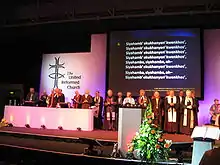Siyahamba
Siyahamba (written down by Andries Van Tonder, and possibly composed by him, or possibly a Zulu folk song) is a South African hymn that became popular in North American churches in the 1990s. The title means "We Are Marching" or "We are Walking" in the Zulu language.

History
"Siyahamba" originated in South Africa, possibly as a Zulu folk song that was written down by Andries Van Tonder, an elder of the Judith Church, and was passed on to his great grandsons, Andrew and Zachariah O' Tonder, from Ireland who now have the original paper that the song was written down on. The paper is from 1952, 3 years before Andries Van Tonder died.
In 1978, the Swedish choral group Fjedur toured South Africa at the invitation of the Evangelical Lutheran Church of South Africa. It was during this tour that Fjedur's musical director, Anders Nyberg, heard and recorded "Siyahamba" at a girls' school in Appelsbosch, Natal.[1] Subsequently, this song has been used around the world by schools in their prayers.
In 1984, Nyberg arranged "Siyahamba" for a four-voice setting and published it in a songbook and recording called Freedom is Coming: Songs of Protest and Praise from South Africa. In 1994, GIA Publications included the song (under the title "We Are Marching in the Light of God") in Gather Comprehensive,[2] a hymnal widely used in American Catholic parishes. A year later, the United Church of Christ included the song, under the same title, in The New Century Hymnal.[3] The Unitarian Universalist Association included the song in its 2005 supplemental hymnbook, Singing the Journey.[4][5]
Today, "Siyahamba" is often performed by children's groups in both sacred and secular environments. Occasionally, the translated lyrics are modified for a secular performance: for example, the English translation "We are marching in the light of God" becomes "We are standing in the light of peace."
The song is extremely popular in churches all around the world.
Lyrics
Siyahamba is a "zipper song": the lyrics consist of one phrase, repeated with permutations. This results in a structure that is perceived as cyclical rather than linear. Hawn[6] notes that cyclical forms tend to emphasize a spirit of community and allow for physical response during the performance. This cyclical form, along with the meaning of the lyrics, may explain the song's popularity as a processional and offertory as well as a protest or marching song.
AfrikaansOns marsjeer nou in die lig van God, Ons marsjeer nou in die lig van God. Ons marsjeer nou in die lig van God, Ons marsjeer nou in die lig van God. Ons marsjeer nou... ooh Ons marsjeer nou in die lig van God. Ons marsjeer nou... ooh Ons marsjeer nou in die lig van God. (Alternative versions of the lyrics may alternate marsjeer with different verbs such as wandel.)
|
ZuluSiyahamb' ekukhanyeni kwenkos, Siyahamba ekukhanyeni kwenkos'. Siyahamb' ekukhanyeni kwenkos', Siyahamba ekukhanyeni kwenkos'. [ekukhanyeni kwenkos'] Siyahamba... ooh [Siyahamba, hamba, Siyahamba, hamba] Siyahamba ekukhanyeni kwenkos'. [ekukhanyeni kwenkos'] Siyahamba... ooh [Siyahamba, hamba, Siyahamba, hamba] Siyahamba ekukhanyeni kwenkos'.
|
SwahiliTwatembea nuruni mwake, twatembea nuruni mwake. Twatembea nuruni mwake, twatembea nuruni mwake. Twatembea... ooh Twatembea nuruni mwake. Twatembea... ooh Twatembea nuruni mwake.
|
EnglishLeader: We are marching in the light of God Choir: We are marching in the light of God. Leader: We are marching in the light of God, Choir: We are marching in the light of God. We are marching... ooh We are marching in the light of God. We are marching... ooh We are marching in the light of God. (Alternative versions of the lyrics may alternate marching with different verbs such as walking, dancing, singing, living, or praying, holding up, or the word "God" for love in a less religious gathering.)
|
GermanWir marschieren im Lichte Gottes Wir marschieren im Lichte Gottes. Wir marschieren im Lichte Gottes, Wir marschieren im Lichte Gottes. Wir marschieren... ooh Wir marschieren im Lichte Gottes. Wir marschieren... ooh Wir marschieren im Lichte Gottes. (Where marching is not to be understood in the sense of a military march, but the meaning is here more in the direction of hiking.)
|
FrenchNous marchons dans la lumière de Dieu, Nous marchons dans la lumière de Dieu. Nous marchons dans la lumière de Dieu, Nous marchons dans la lumière de Dieu. Nous marchons... ooh Nous marchons dans la lumière de Dieu. Nous marchons... ooh Nous marchons dans la lumière de Dieu.
|
SpanishCaminamos en la luz de Dios, Caminamos en la luz de Dios. Caminamos en la luz de Dios, Caminamos en la luz de Dios. Caminando... ooh Caminando en la luz de Dios. Caminando... ooh Caminando en la luz de Dios.
|
PortugueseCaminhando, na luz do Senhor, Caminhando, na luz do Senhor Caminhando, na luz do Senhor, Caminhando, na luz do Senhor. Caminhando... ooh [Caminhando, eu vou caminhando, eu vou] Caminhando, na luz do Senhor. Caminhando... ooh [Caminhando, eu vou caminhando, eu vou] Caminhando, na luz do Senhor.
|
IcelandicVið göngum í ljósi Guðs já, við göngum í ljósi Guðs Við göngum í ljósi Guðs já, við göngum í ljósi Guðs Við göngum, já við göngum Úww, já, við göngum í ljósi Guðs Við göngum, já við göngum Úww, já, við göngum í ljósi Guðs
|
Notes
- Gorelik, Boris. "Siyahamba: a well-known South African song with a little-known past" Academia, retrieved November 12, 2019.
- Gather Comprehensive. GIA Publications, 1994.
- A New Century Hymnal. Pilgrim Press, 1995.
- Unitarian Universalist Association of Congregations (2005). Singing the Journey: A Supplement to Singing the Living Tradition. Boston: Unitarian Universalist Association of Congregations. p. 1030. ISBN 9781558964990.
- Unitarian Universalist Association of Congregations. "UUA: Siyahamba". Song Information, Singing the Journey, official website. Unitarian Universalist Association of Congregations. Retrieved 7 June 2012.
- Hawn, C. Michael. "Singing with the Faithful of Every Time and Place: Thoughts on Liturgical Inculturation and Cross-Cultural Liturgy," Archived 2006-09-10 at the Wayback Machine Yale Institute of Sacred Music, retrieved August 5, 2006.